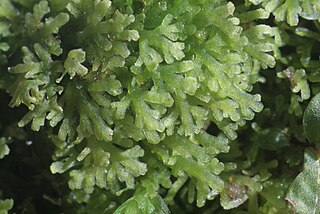
Metzgeriales is an order of liverworts. The group is sometimes called the simple thalloid liverworts: "thalloid" because the members lack structures resembling stems or leaves, and "simple" because their tissues are thin and relatively undifferentiated. All species in the order have a small gametophyte stage and a smaller, relatively short-lived, spore-bearing stage. Although these plants are almost entirely restricted to regions with high humidity or readily available moisture, the group as a whole is widely distributed, and occurs on every continent except Antarctica.

Riccia is a genus of liverworts in the order Marchantiales.

Sphaerocarpos is a genus of plants known as bottle liverworts. There are eight or nine species in this genus.

Sphaerocarpaceae is a family of liverworts known as bottle liverworts. Approximately ten species are included in this family, most of them in the genus Sphaerocarpos, but one additional species in the genus Geothallus.

Targionia is a genus of liverworts in the order Marchantiales. It the only genus in the family Targioniaceae within that order. This genus has worldwide distribution in areas with a Mediterranean climate. That is, in regions with hot dry summers and cool wet winters.

Monosolenium tenerum is a weedy species of liverwort found in east Asia. It is the only species in the genus Monosolenium and the family Monosoleniaceae.

Plagiochila is a large, common, and widespread genus of liverworts in the order Jungermanniales. It is a member of the family Plagiochilaceae within that order. There may be anywhere from 500 to 1300 species, most of them from the tropics; the exact number is still under revision. The genus also has a wide distribution in temperate and arctic areas.
Noteroclada is a small genus of liverworts of the Southern Hemisphere. It is classified in order Pelliales and is the only genus in the family Noterocladaceae within that order. Unlike Pellia, the other genus in the order, Noteroclada has a leafy appearance.

Pallaviciniaceae is a widely distributed family of liverworts in the order Pallaviciniales. All species are thallose, typically organized as a thick central costa (midvein), each side with a broad wing of tissue one cell in thickness. All species are dioicous. The greatest diversity is in Australasia, with some species endemic to that region, though species belonging to the family may be found on every continent except Antarctica.

Lepidozia is a genus of liverwort in the family Lepidoziaceae. It was first proposed by Dumortier in 1835.
Phycolepidozia exigua is the only species of liverwort in the genus Phycolepidozia and family Phycolepidoziaceae. It is endemic to Dominica, where it is critically endangered. Its natural habitat is subtropical or tropical moist lowland forests.

Haplomitriopsida is a newly recognized class of liverworts comprising fifteen species in three genera. Recent cladistic analyses of nuclear, mitochondrial, and plastid gene sequences place this monophyletic group as the basal sister group to all other liverworts. The group thus provides a unique insight into the early evolution of liverworts in particular and of land plants in general.
Apotreubia is a genus of liverworts in the family Treubiaceae. There are four species, including: Apotreubia nana, which is found in subalpine New Guinea, and Apotreubia pusilla, which has a disjunct distribution between eastern Asia and British Columbia.

Treubia is a genus of liverworts in the family Treubiaceae. There are seven species, all of which are restricted to the southern hemisphere. Five of the species occur in Australasia and the other occurs in Chile. All species are dioicous, with separate male and female gametophytes.
Sandeothallus is a small genus of liverworts restricted to East Asia. It is classified in the order of Pallaviciniales and is the only member of the family, Sandeothallaceae within that order.
Allisonia cockaynei is the only species of liverwort in the genus Allisonia and family Allisoniaceae. It is endemic to New Zealand.
Makinoa crispata is the only species of liverwort in the genus Makinoa and family Makinoaceae. The genus Verdoornia was formerly included in this family, but has been transferred to the family Aneuraceae on the basis of recent cladistic analysis of genetic sequences.

Pleurozia is the only genus of liverworts in the family Pleuroziaceae, which is now classified in its own order Pleuroziales, but was previously included in a broader circumscription of the Jungermanniales. The genus includes twelve species, and as a whole is both physically distinctive and widely distributed.

Ptilidium is a genus of liverwort, and is the only genus in family Ptilidiaceae. It includes only three species: Ptilidium californicum, Ptilidium ciliare, and Ptilidium pulcherrimum. The genus is distributed throughout the arctic and subarctic, with disjunct populations in New Zealand and Tierra del Fuego. Molecular analysis suggests that the genus has few close relatives and diverged from other leafy liverworts early in their evolution.
Treubia scapanioides is a species of liverwort in the family Treubiaceae. Until recently, the genus was placed in the order Metzgeriales. There are only 6 species in the genus Treubia. Five are native to Australasia but T. scapanioides is known only from Chile.













